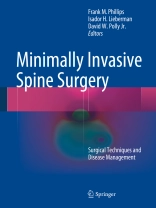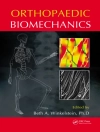Over the past decade, minimally invasive techniques have developed rapidly and are widely applied in the management of spine disorders. With the development of enabling technologies, including specifically designed spinal retractor systems, intraoperative imaging and navigation technologies, and real-time neural monitoring, minimally invasive spine surgery (MISS) techniques are safe, effective and reproducible. Indeed, studies have confirmed the clinical and economic advantages of these procedures.
Minimally Invasive Spine Surgery includes detailed discussions of enabling technologies, surgical techniques (including posterior decompression and fusion), approaches to specific diseases and conditions, as well as strategies to manage the unique risks and complications of MISS. Generously illustrated, this will be an essential reference for orthopedic surgeons, neurosurgeons and all health care professionals who treat the spine.
قائمة المحتويات
Part I: Introduction.- History and Evolution of Minimally Invasive Spine Surgery.- Philosophy and Biology of Minimally Invasive Spine Surgery.- Economics of Minimally Invasive Spine Surgery.- Part II: Enabling Technologies for Minimally Invasive Spine Surgery.- Microscopes and Endoscopes.- Intraoperative Neurophysiology Monitoring.- Image Guidance.- Robotic Assisted Spine Surgery.- Fusion Biologics.- Lasers.- Part III: Surgical Techniques: Minimally Invasive Posterior Decompression.- Posterior Cervical Decompression.- Thoracic Decompression.- Lumbar Decompression Using a Tubular Retractor System.- Part IV: Surgical Techniques: Fusion.- Minimally Invasive Posterior Cervical Fusion.- Percutaneous Pedicle Screws.- Minimally Invasive Facet Screw Fixation.- Minimally Invasive Transforaminal Lumbar Interbody Fusion.- Mini-Open Anterior Lumbar Interbody Fusion.- Minimally Disruptive Lateral Transpsoas Approach for Thoracolumbar Anterior Interbody Fusion.- Presacral Approaches for Minimally Invasive Spinal Fusion.- Mini-Open Lateral Thoracic Fusion.- Thoracoscopic Fusion.- The Painful Sacroiliac Iliac Joint.- Part V: Disease-Specific Approaches.- Cervical Herniated Nucleus Pulposus and Stenosis.- Thoracic Herniated Nucleus Pulposus.- Lumbar Herniated Nucleus Pulposus.- Lumbar Spinal Stenosis.- Minimally Invasive Spine Surgery in Lumbar Spondylolisthesis.- Adolescent Scoliosis.- Adult Scoliosis.- Anterior Column Realignment (ACR): Minimally Invasive Surgery for the Treatment of Adult Sagittal Plane Deformity.- Thoracolumbar Spine Trauma.- Minimally Invasive Surgery for Spinal Tumors.- Pathological Fractures.- Minimally Invasive Spine Surgery in the Elderly.- Minimally Invasive Applications of Motion.- Part VI: Minimally Invasive Spine Surgical Complications.- Choice of Minimally Invasive Approaches: A Review of Unique Risks and Complications.- Minimally Invasive Spine Surgery Complications with Implant Placement and Fixation.- Neural and Dural Injury.- Pseudarthrosis. >
عن المؤلف
Frank M. Phillips, MD, Rush University Medical Center, Department of Orthopedic Surgery, Chicago, IL, USA
Isador Lieberman, MD, MBA, FRCSC, Texas Back Institute, Plano, TX, USA
David W. Polly, Jr., MD, University of Minnesota, Department of Orthopedic Surgery, Minneapolis, MN, USA












